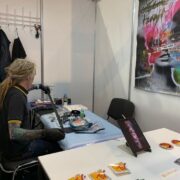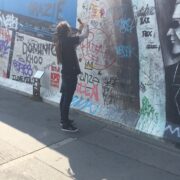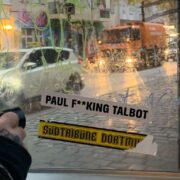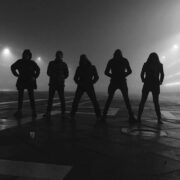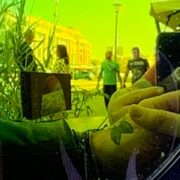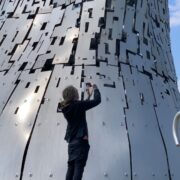This time I’m going to attempt to answer this question from our youtube channel (youtube.com/thattattooshow).
“Really love this show man, you guys give me good company every Monday. I wanted to say Paul, once, you told a bit of your story in the “cup of tea” episode, and it was really cool and inspiring but it got me curious, how tattoo started for you and your story with Tattoo as you don’t go that far in the podcast. Would be awesome to hear how you got into tattooing and the ups and downs of becoming a tattoo artist”.
When I first read this question I sat down to answer it thinking that it would be quick and simple. However, I very quickly realised that the ‘how’ of how I got into Tattooing really isn’t that different from most of the artists I know. Like, pretty much, everyone I know, I got a little setup practiced and practiced on (in my case) pigskin until my efforts looked reasonably professional and then started scarring my friends and family for life! But this answer honestly doesn’t really offer any insight into my art or any of the major decisions I’ve made along the way.
But the ‘why’ of it? Now, that’s a very different story…
When I looked at why I got into tattooing and the sequence of decision’s and left turns that my career has taken I started to notice a pattern in the ups and downs. A pattern that continues throughout my entire life. It forms the core of my beliefs about art and commerce and the difficult relationship that those two uncomfortable bed fellows present.
As I began mentally structuring this column I realised that – over the years – the reason I have turned my back on a couple of semi-successful careers hasn’t been (as I thought) because I ran out of road in them. It was because business and the commercial pressures that come with art as a business had invaded my world to such an extent that I had simply walked away. And mostly for good reasons.
Meet the new boss, same as the old boss.
For many artists, me included, the pursuit of our craft is more than just a hobby or a career. It’s a calling. An innate need to create and express ourselves through our chosen medium. However, with the rise of commercialism and big business in the creative worlds, it can be challenging for artists to stay true to our artistic vision without giving in to the pressures of making money and pleasing sponsors.
Throughout history, the church was one of the most significant patrons of the arts. This support was often essential for artists, who have had to rely on patrons to fund their work and support their livelihoods. For artists, this often meant that they had to bow to the pressure of creating religious art for money rather than art for the sake of art. They had to create works that would satisfy their patrons and convey the appropriate religious messages, regardless of their personal artistic vision or style. The church was one of the few institutions that could provide stable and reliable funding for artists, and so many artists had no choice but to work within the system.
This compromise still exists today. But, in a world where art is increasingly seen as a commodity it is big business and not the church that is todays major patron of the arts.
Welcome to the machine, where have you been?
My initial chosen medium was music. I was then and I am still a guitar player, nothing more. Music was and remains my first great love. At 17 I was working in a recording studio as a ‘Tape OP’, had a record deal and was a touring, professional musician. By 21 I had 2 grammy nominations and a ‘showreel’ of major label releases to my name. Including a Number 1 ‘Hit Single’. I was being to asked to record and mix albums by some very famous names from the rock, metal, pop and reggae worlds. Everything was going great. Until it wasn’t.
I’d very quickly gone from working with small indie labels, run out of bedrooms to taking calls from major labels. Having grown up in a (very) broken 70’s suburban home, I was Ill equipped to deal with any of it. I was young, starry eyed and naive. Unsurprisingly, I got fucked. Over and over again. Not by the musicians who loved what I did to their sound but by the business and the business people.
For them, music was simply a commodity. A commodity that was easily compromised. Forget your ‘artistic visions’ let’s just make the work more palatable to the masses. Sell out and sell a million copies. “Are the cymbals ‘West Coast’ enough?” “Don’t bore us, get to the chorus” etc etc. And it left me feeling unfulfilled and – to be honest – a bit grubby. I had taken my great love and dressed her like a cheap hooker. I hated it. Every fucking soulless minute of it.
As Hunter S Thompson once said “The music business is a cruel and shallow money trench, a long plastic hallway where thieves and pimps run free and good men die like dogs. There’s also a negative side.”
I wanted no part of that version of the business but I couldn’t see a way of staying in ‘the biz’ without dealing with them. The truth of the music business was a huge shock to me. I found myself the last person in the room who cared about the actual music and I didn’t yet have the life tools or coping skills to understand or resolve my frustrations. Shit! I couldn’t have even verbalised my frustration at the time. All I ‘felt’ was anger but, in retrospect, it was much more than that and closer to betrayal. I’d been sold a lie by the music press and I’d fallen for it. My eyes weren’t open to the obvious truth and, by the time they were, it was too late.
The presence of big business and the soulless, money fixated sharks pissing in the pool had made the water taste bad. Without the confidence or ability to transition to a better position, I got out of the pool and started looking for something else to do with my life. I walked away from my first love and for the first time in my I prioritised my love of the art form over commerce.
Could I have done things differently? Well, yes and honestly no. Coming from where I was coming from, I simply didn’t have the life experience, vocabulary or the self awareness to cope with and respond to the feelings of disillusionment yet. I couldn’t even spell ‘disillusionment’ when I was 23, let alone understand it. It was going to take at least one more failure before I realised that I was part of the problem and partly to blame. And that I needed to learn much more than just ‘art shit’ to survive.
Clever got me this far, then tricky got me in.
Honestly I was dummy. Intelligent but uneducated. Not particularly well read but full of opinions based on my adventures ‘on the road’. By this point I’d travelled the world but seen and learnt nothing. I liked to think I was street smart but – in fact – I was a product of the dirty end of the music business. Ruthless, self centred, angry, bitter and manipulative. They stole my dream so I don’t have to give a fuck about anyone. That was my (bad) attitude.
So much so that when I blagged my way into a publishing company and then manipulated my way into the design department and put myself in the frame to replace the outgoing manager. I thought I was being ‘cagey’ and clever. Playing the corporate game and winning at it. Fuck these suits right? I’ll get what I want. Who cares who gets hurt along the way. It’s about me. All the time not realising that I was the one getting hurt. Because I was compromising everything that mattered to me.
That was my immature response to the betrayal I’d felt from the music business. Unable to resolve my feelings or see any way of making art without the presence of commerce, I’d decided to become one of them. Just give in, lie down and get fucked by big business. In retrospect its a crazy response. But crazy was all I had.
Of course, rather than ‘beating them at their own game’ I was a ‘lamb to the slaughter’. In a blue tie wearing, suited and booted clusterfuck. My life was a slow motion train-wreck unfolding before my blindfolded eyes. And that was very nearly the end of the story. Rotting away in an office. With the demands of the production department sucking the life out of me. I had to get out. And I had another mistake to make before I finally wised up.
What a waster, what a fucking waster.
I’d left the publishing company a couple of years earlier to set up my own, semi-successful, agency. Partly because I had found my second love – Graphic Design. I knew the term but didn’t fully understand what it was until I was able to research it. Surrounded by books and magazines all about graphic design I slowly found my way towards the 90’s grunge typography movement and the work of David Carson, Neville Brody and Vaughn Oliver. I fell head over heals in love with this visual style but there was zero outlet for it in local advertising. So I left to pursue my new passion. This time it was going to work.
My initial dream of working with music business clients making album art quickly had to be replaced. I was too late to the grunge type movement. By the time I’d developed a style the world had moved on and it was no longer fashionable. Plus, the album cover was dead. In fact, the music business was dead. It just didn’t know it yet. So I’d started working with bigger and bigger corporate clients. I hadn’t sold my soul, I’d just given it away.
I found myself in London pitching for a quarter of a million pound account. I knew I’d got it. This wasn’t my first rodeo. Over the preceding decade I had become very good at playing ‘the corporate game’ Very, very good. I was dead inside but didn’t know it yet and even a quarter of a million quid account wasn’t going to make me happy. Not even slightly.
As I walked towards the lift away from the meeting chatting with my business partner, I stepped out of the way of a guy walking towards me. He also sidestepped. Just as I was preparing my ‘fancy a dance’ witty quip I realised that there was no-one there. It was a mirror that I was walking towards and I simply hadn’t recognised myself as I walked towards it.
As I stood waiting for the lift I studied the ‘person’ before me. Short, spiky, black designer haircut, ‘get along’ Gucci glasses, blue pinstripe power suit, brown designer computer satchel and matching Chelsea boots. The 17 year old guitar player inside my head starts singing “What a waster, what a fucking waster” And he was right. I was the image of compromise. A two bob c*nt.
In the car on the way home I called Carron. “Did you get it?” she said, “Yep, but I’m not taking it. I’ll explain when I get home”.
Here in my car, where the image breaks down.
That car journey was one of the defining moments in my life. I don’t remember a word being spoken. I’ve never been so lost or lost in thought. Either before or after. It’s a short journey from London to Birmingham but, in my memory of it, it last for days. During that journey and in the following days I finally figured out how and why I’d got off the path I’d started on.
Thankfully, by this point in my life I was better educated and far more self aware. (As it turned out I still far more ‘work’ to do building Paul, but that’s another story for another day). People with my personality traits tend to have an inexhaustible thirst for knowledge. I’m no different and the early version of the internet was perfect for an ‘Info Freako’.
Hours of reading had filled in the gaps in my knowledge and provided me with enough research to understand my personality, both positive and negative sides and how to resolve them in order to live like a normal human being. Through sheer force of will I had taken myself and my understanding of the world beyond my ‘default’ working class upbringing and education. I was ready to take everything I’d learnt from every version of my life so far and put them all to good use. But not for money, for art. My art, my way. No compromise, no business bullshit and definitely no fucking suits. The time was right and this time it was going to work. But what artform? Music? no. Graphic Design? no. I was going to have to find a new passion and protect it from all the outside stuff at all costs.
I get by with a little help from my friends.
It was during the shutting down and walking away part of closing my agency for good that I started reconnecting with old friends from the music world. Most of them had moved on and a couple of them were now tattooists.
So I got tattooed and we chatted. We caught up on old times and talked about the future. ‘Why don’t you tattoo?’ came up pretty early on and I explained that – even though I love tattoos – I didn’t see a way of doing my art in that medium. At the time new school was huge, I loved it because it reminded me of the indie comics I loved to read. But the style I developed relied heavily on digital collage and image manipulation techniques and I couldn’t (yet) see it translating onto skin. Neither could my friends. In all fairness to them they weren’t the most technical or modern of tattooers so they couldn’t offer any ideas of how graphic design could become tattoos.
So I sat and considered my options. But all my ideas ran into dead ends. I’d always wanted my own recording studio but at the time studios all over the world were being faced to close their doors forever in the face of the new digital era. 20 years later all but the biggest studios are gone and the ones that are left fill their diaries with sessions for video game and movie soundtracks so my ‘gut feeling’ that a studio would fail turned out to be true. I was still running my design agency and the work I was getting was miles away from what I wanted to do. I just couldn’t see a way of making art, any kind of art, whilst avoiding the pressures and inevitable compromise that I would surely have to make.
That was until, during one conversation while I was getting one of my sleeves finished my friends wife presented me with a German tattoo magazine saying ‘theirs some weird tattoos in there that look a bit like the stuff you make on your computer’ she said. The couple of pics in the mag that she was referring too were works by Noon, Jeff Palumbo and Yann Black. Honestly, If you were in the room at the time i’m sure you’d have seen the lightbulb appear above my head. It was game on.
So, with a little help from my friends, I began teaching myself to tattoo and figuring out how to translate my digital art into my new favourite medium. I didn’t know at the time but I was at the very beginning of a small emerging scene in tattooing. A scene with no name and very few fans especially amongst tattooists. Unbeknown to me tattooing can be surprisingly conservative for a low brow outsider artform and my work certainly made a few people very angry in the early days. It was during these early days of posting and subsequently defending every single piece I posted on social media that I realised that my failed creative efforts up to this point had accidentally given me the experience and ability to contextualise the negativity I was facing. I could draw from knowledge gained outside tattooing to succeed. Even in the face of a largely hostile industry. Because I knew of people who had done exactly that in other industries.
I am a patient boy.
In the early days I struggled to break into the industry. Conventions gleefully turned me down when I asked for a booth, sending me rude emails about my work and it’s ‘place’ in tattooing. Magazines refused to publish my work claiming that it was fake and not actually tattooed into skin but rather cleverly photoshop on to appear as if it was tattooed. But, all the time I was banging my head against the wall that was the tattoo industry, my diary was filling up with clients who loved my work. And this was where my experiences in the music industry started to inform my future business strategies.
Metallica succeeded in their early days primarily through relentless touring and word-of-mouth buzz. Fans who saw them live would often spread the word to their friends, creating a grassroots fanbase that grew larger with each tour. While radio play certainly would have helped to boost their profile, Metallica’s early success shows that with hard work, a unique sound, and a loyal fanbase, it is possible for a band to make it without mainstream radio support.
So I decided to take that idea and adapt it to my situation. Unable to get a foothold in the UK I travelled to where people liked and accepted my work. I spent the next few years doing guestspots and working conventions all over Europe. Especially in Italy, which is now like a second home to me and a place that I will always have a special place in my heart for.
My uncompromising ‘art by any means necessary’ ethos also comes from my inspirations. Hardcore bands like Fugazi sidestepped the music biz, preferring to run the band like a small cottage industry. Forget the rockstar trappings, huge sales and fame. The went for a small, independent, sustainable model based on great music first. Building a lifestyle around the music, rather than making any kind of music simply to support a rockstar lifestyle.
David Carson – who was hated in the early days by the high priests of design for his chaotic, rule breaking style simply – stared them down. He refused to compromise and fall ‘in step’ preferring, instead, to hold fast and never compromise his vision. Years later he gives lectures on the genius of his style and his unique – and often copied – approach. His critics – by way of comparison – have all but disappeared. Retiring into the shadows with their opinions looking laughably wrong in the face of history.
I did so much work in Europe that when – eventually – UK conventions had to give in and allow me to work their shows visitors thought I was an Italian artist. One UK promoter even told me that I am still one of the artists most requested by visitors to this day. All because I took inspiration from the relentless touring of Metallica, the hardcore attitude of Fugazi and the uncompromising attitude of David Carson.
It was these inspirations and experience gained from my previous failures that allowed me to sidestep the industry whenever I had to without worrying about fitting in. So, a couple of years later when I was working conventions, winning awards and getting featured in magazines all over the world and the industry (and the business) came knocking I was completely prepared (this time) to take them on and – for the first time – not get fucked.
As I sure you can guess by now, I have zero time for ‘corporate’ tattooing and the bullshit that comes with it. I’ve seen the truth of that in other the worlds I worked in and these days I’ll only get involved if conditions are perfect. So I have very few sponsorships. I prefer to just work with brands without any kind of contract in place as it keeps everyone ‘honest’. But I don’t look down on or feel superior to anyone who does. Partly because I (loosely) subscribe to the Buddhist philosophy of life.
Buddhists believe that this suffering is caused by craving or “Tanha”. The Buddha taught that the path to ending suffering involves recognising its cause and letting go of attachment to desires. This is known as the “Fourth Noble Truth”
Put simply, we all have to choose what we are prepared to suffer for. I will suffer lower income and a simpler lifestyle in return for artistic freedom. But I have friends who prefer to have more lavish lifestyles and will get involved with corporates and lock step with the industry to achieve that. They are neither right or wrong, they’re just prepared to suffer for different things than myself. This headspace allows me to maintain friendships with all kinds of people without the need for everyone to see the world the way I do. We simply respect each others version of life as perfect for them.
Anne, what am I supposed to do, it’s been bugging them since the day that I was born.
Bringing the story into the present, I thought I was doing fine until a Pandemic changed my mind. 8 months spent locked in my head gave me the first time since I got into this world to stop and really take stock. I realised that even though I had plenty of creative freedom I’d accidentally allowed myself and my portfolio to get painted into a corner. Inadvertently, I’d become a victim of my ‘success’.
When I started out I made artwork and sold it to clients, simple. But as time went along clients began to request ‘something like that one you did’. So I created portraits in the style of a previous one or a similar a layout to a previous tattoo. Slowly the parameters of my style started to close in. There’s only so many ‘Crow’ tattoos or Dali or David Bowie portraits you can do before your world starts to feel a little like Groundhog Day. After a while you realise that the downside of commissioned work is that the themes and styles your requested will always be repeats of previous pieces and that your portfolio and your creativity starts to suffer. Post Pandemic it was time for another course correction.
Over the last couple of years I’ve been working towards getting back to my original way of selling tattoos. I’ve stopped using social media to promote my work preferring to maintain a small mailing list of fans who signup via my website. I do ‘drops’ of artwork every few months and sell the art – as is – to them.
This smaller and more exclusive approach – which is not dissimilar to the Fugazi/Hardcore model works perfectly for me. It allows me to maintain a diverse and ever expanding portfolio of ideas and it gives my clients the added benefit that they can select their new piece from a selection of pieces rather than being presented with a single piece on the day of their appointment.
This idea is really nothing new. In fact it’s closer to the way tattoos have been sold for years. Back in the day, picking a new tattoo way much easier and far less stressful. You walked into a parlour, stared at the walls of pre-drawn art or ‘Flash’ until something jumped out at you.
The term “flash” is derived from the traveling carnival and circus trade in the late 1800s: an attraction needed to be eye-catching to draw in the crowd, and that visual appeal was called flash. Tattoo artists working at those carnivals would hang up their designs in front of their booths to catch people’s attention, so they adopted “flash” as a term for this artwork.
Flash was either drawn by the individual tattooist for display and use in their own studio or traded and sold among other tattooists. Disseminating styles and designs across a broad community. The beauty of this system was that not only where you able to see, really see, what your new tattoo was going to look without spending any money. But also, you were always looking at designs that were made to be tattooed. Not paintings, not photos, not pencil sketches. Tattoos. Each design had been carefully and professionally put together to work on skin by a skilled tattooist.
The ‘everything custom’ phase of tattooing started in the 80’s. Mainly because it was a way of charging more for your services and partly for ‘bragging rights’. “I’m a custom artist so I’m better than a flash tattooer” was the prevailing attitude. Fast forward to today. Everyman and his dog is an ‘award winning, internationally renowned, custom artist’. But is custom better for the client?
During the early days of ‘Tattoo TV’ the reality show makers responsible for shows like Miami Ink pushed a narrative about tattoos having meanings. The truth is that tattooing has always had meaning. But until it suited the needs of TV execs the meaning of the tattoo was separate from the images used. The image didn’t have to depict the exact meaning. It was chosen, by the client, in a more abstract way.
These days clients are convinced that every tattoo must have a meaning and a story behind it. Regardless of how the finished result actually looks. This is a ‘modern’ idea but it’s not necessarily a better idea. Times are changing. Clients are preferring to choose art. Favouring the ‘old way’ of choosing from designs they can – once again – see in advance. They prefer to choose from a selection of pieces by their favourite artist and find the perfect one for them. This abstract image takes on any meaning you give it because that why you got it.
CHOOSE ART. ADD YOUR OWN MEANING.
